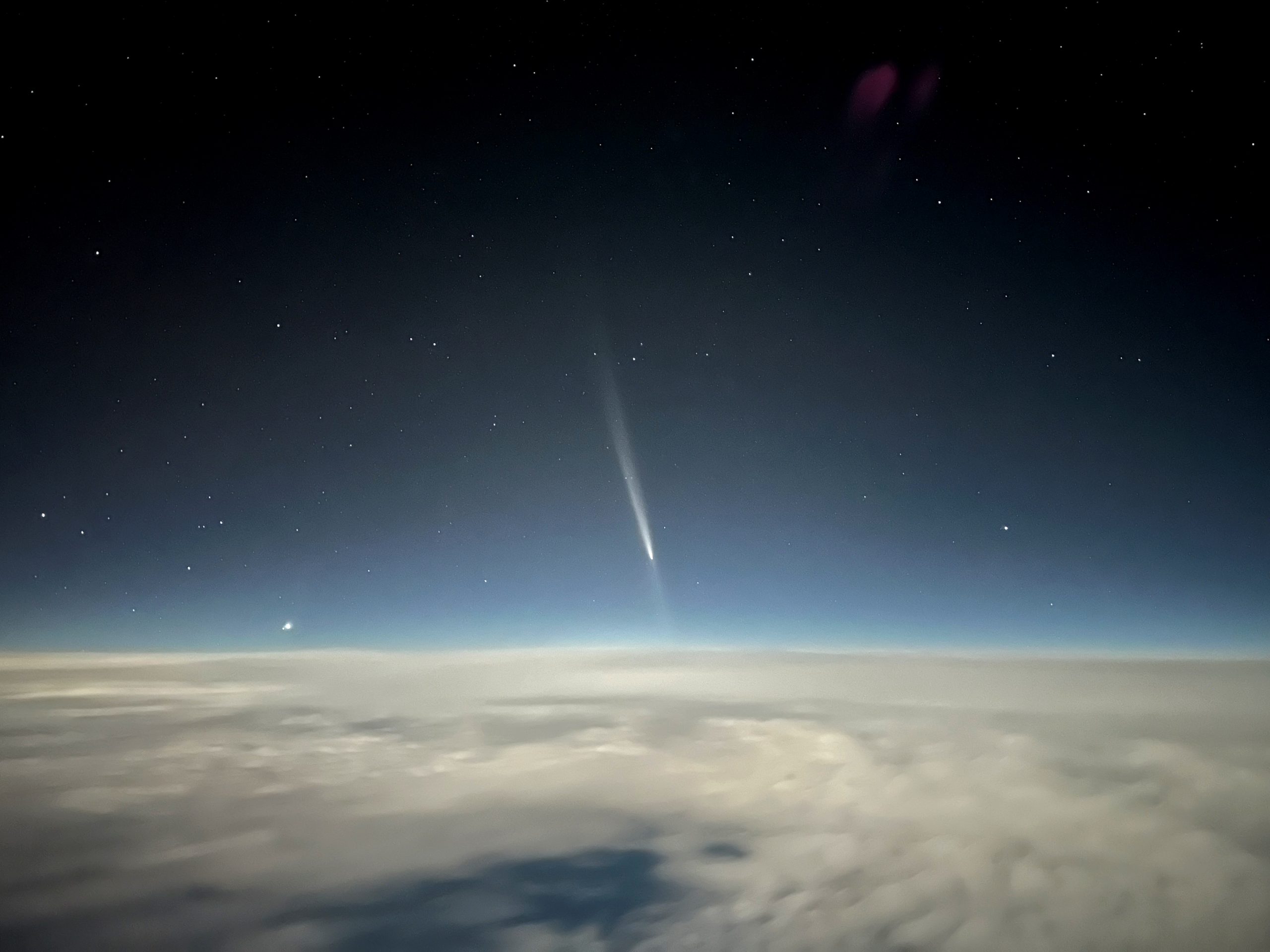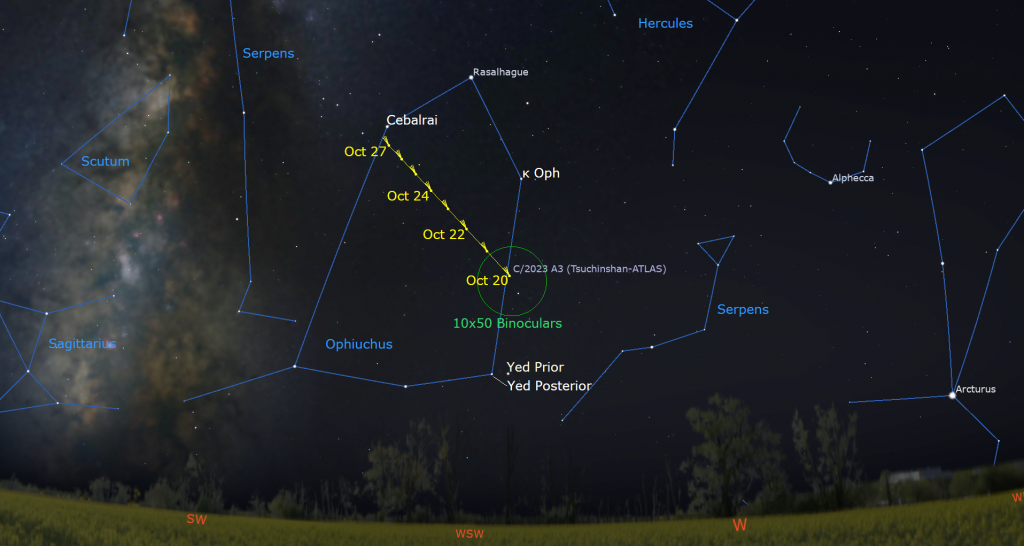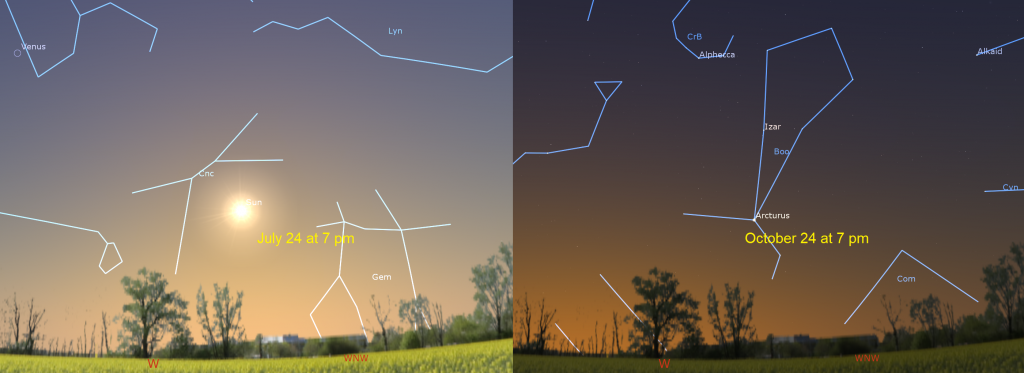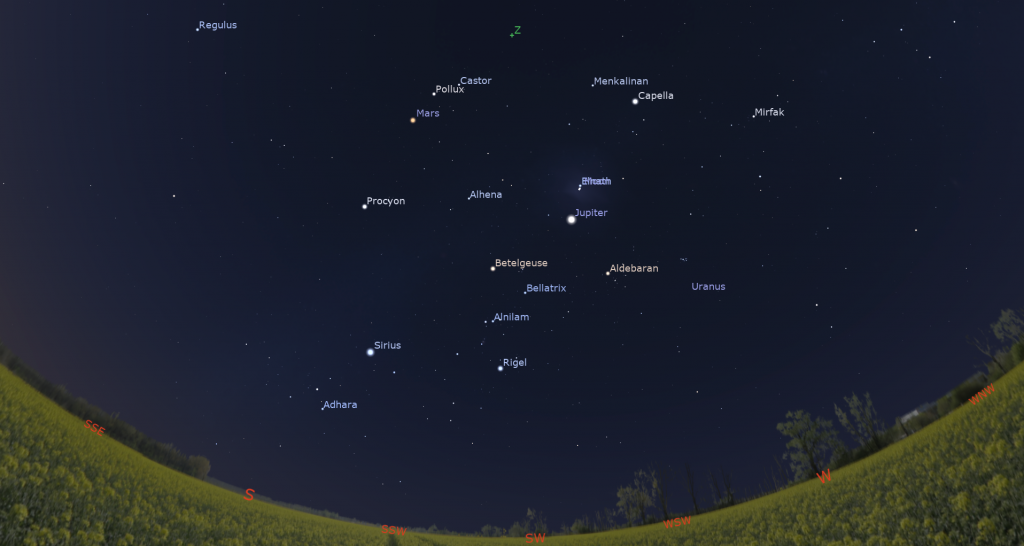The Meteor-Spoiling Moon Moves into Morning, the Night’s Full of Planets, and a Comet Sees a Ghost after Sunset!

My neighbour is a pilot and captured this terrific image of comet C/2023 A3 (Tsuchinshan-ATLAS), complete with anti-tail pointing downward, on October 14 while en route. That’s Venus at lower left, Arcturus a bit higher at right, and the star 110 Virginis directly above the comet.
Hello, Late-October Stargazers!
Here are your Astronomy Skylights for the week of October 20th, 2024 by Chris Vaughan. Feel free to pass this along to your friends and send me your comments, questions, and suggested topics. You can also follow me on Twitter as @astrogeoguy! Unless otherwise noted, all times are expressed in Eastern Time. To subscribe to these emails please click this MailChimp link.
If you’d like me to bring my Digital Starlab portable inflatable planetarium to your school or other daytime or evening event in Simcoe, Grey, and Bruce Counties, or deliver a virtual session anywhere, contact me through AstroGeo.ca, and we’ll tour the Universe, or the Earth’s interior, together! My book with John A. Read entitled 110 Things to See With a Telescope is a guide to viewing the deep sky objects in the Messier List – for both beginners and seasoned astronomers. DM me to order a signed copy!
The bright, but later-rising moon will offer a couple of more opportunities to view Comet Tsuchinshan in early evening, along with Arcturus as the Ghost of the Summer Sun. All of the planets are in the night sky, though Mercury will be tough to see, and the Orionids meteor shower will peak in a moonlight sky. Read on for your Skylights!
Comet Tsuchinshan Update
Did you see comet C/2023 A3 (Tsuchinshan-ATLAS)? I managed to see it with my unaided eyes last Wednesday and photographed it with my Seestar S50 robotic telescope on the following evening. Now it is fading in brightness with each passing day as it flees from the heart of the solar system. Tonight and tomorrow night after dusk, before the bright moon rises in the east, will be good opportunities to see the comet in the west while it is still reasonably close.

For the next several weeks the comet will appear in the western sky during early evening, but you will need binoculars or a small telescope to see it well. The comet’s orbital motion will carry it up and to the left (or celestial east) each night. Tonight (Sunday), see if you can locate the medium bright, side-by-side pair of stars named Yed Posterior and Yed Prior (or Delta and Epsilon Ophiuchi), and then search less than a fist’s diameter directly above them. The word “yed” means hand, since those stars form the hand of the Serpent-Bearer. The words prior and posterior refer to the fact that the right-hand star leads the left-hand star across the sky.

On each subsequent night, the comet will shift several finger widths to the upper left. At the end of this week, the comet will pose just below (or celestial southwest of) the bright star named Cebalrai (or Beta Ophiuchi). The comet is approaching a rich part of the Milky Way, so imagers should frame their photos to include some of the star clusters in the vicinity of the comet.
Expect to see the comet as a bright little star surrounded by a fuzzy halo. I’m used to seeing comets as green, but this one had a very golden hue. The long tail will extend upwards to the left, away from the sun (though your telescope will likely flip or mirror that). See if you spot a thin, faint anti-tail pointing down towards the right towards where the sun would be. That’s the trail of dust left in the comet’s wake.
Wishing you clear skies and good viewing!
The Ghost of the Summer Sun
During the week before Halloween, especially Oct 25, the bright star Arcturus becomes “the Ghost of the Summer Sun”! That’s because its sits at about the same altitude and azimuth in the sky that the sun did exactly four months earlier at the same time of the evening – in broad daylight, though.

Orionids Meteor Shower
We’ve entered meteor shower season! Over the next few months, Earth will experience several showers. My late friend Blake Nancarrow created a very informative graph of meteor shower intensity throughout the year here, on his Lumpy Darkness blog.
The excellent Orionids Meteor Shower, which is observable world-wide, happens every year between September 26 and November 22 while the Earth is plowing through a cloud of fine particles dropped by repeated past passages of the periodic comet designated 1P/Halley, or simply, Halley’s Comet. The Orionids (for short) will peak in the Americas overnight tonight (Sunday, October 20), though this year’s shower will be spoiled by a bright moon. Start watching for Orionids after dusk on Sunday night, before the gibbous moon clears the rooftops at around 9 pm. Those meteors may be longer. The most Orionids will appear in the Americas before dawn on Monday morning, when the sky overhead will be plowing directly into the particle field, generating as many as 10-20 meteors per hour. Although not especially numerous, Orionids are known for being bright and fast-moving.
The meteors can appear anywhere in the sky, but true Orionids will seem to be travelling in a direction away from a location in the sky called the radiant that is near the bright red star Betelgeuse in the constellation of Orion – giving this shower its name. This year, bright Mars and Jupiter, and the bright moon, will shine near the radiant. The Orionids’ radiant will rise at about 10:30 pm, but up to half of the Orionids will be streaking downwards, and blocked by your local horizon until Orion climbs higher.
While the Orionids Shower will last until late November, the meteors will decrease in quantity every night after Monday morning’s peak. The Orionids has a broad period of activity because the orbit of Halley’s Comet is tilted by only 17° from the plane of the Solar System, and it also crosses Earth’s orbit obliquely. There’s a terrific, interactive, 3D meteor shower visualizing tool at https://www.meteorshowers.org/.

To see the most meteors, first check the weather forecast – you won’t see meteors if it’s cloudy. Get away from light-polluted, urban skies and find a dark site with plenty of open sky. If the moon is up, try to hide it behind a tree or building. Don’t bother using binoculars or a telescope for meteors – their fields of view are too narrow. Don’t focus your attention on the sky near the radiant because those meteors will be travelling towards you and will produce very short streaks. Instead, sweep the sky overhead.
To preserve your eyes’ dark adaptation, avoid the bright white light from phones or tablets. Red light is fine – so cover your device’s screen with red film or use its red mode. If the peak night forecast calls for clouds, try the nights before or the nights after. Good luck!
The sky will become much darker when the moon wanes in phase later this week, so keep an eye out for occasional lingering Orionids if you are outside on a clear evening. Another weaker, minor shower derived from debris dropped by periodic comet 2P/Encke is ramping up, too. The Northern Taurids meteor shower will peak in early November. Any meteors you see streaking away from a point in the sky between Saturn and Jupiter will be Taurids.
The Moon
Though the moon will be waning in phase and shifting more and more into the post-midnight sky later this week worldwide, our natural night-light will spoil evening stargazing until the coming weekend. The later-rising moon will linger well into the morning daytime sky, where it will shine as a ghost of the night. It’s perfectly safe to view the moon in binoculars and telescopes in the daytime as long as you ensure that nobody turns them around and aims at or near the sun.
Around mid-evening tonight (Sunday), the bright, waning gibbous moon will rise in the east with brilliant Jupiter shining a palm’s width to its lower right (or 6 degrees to its celestial southwest). The prominent star Elnath, which marks the northern horn tip of Taurus (the Bull), will sparkle just to the lower left of the moon. The trio will shift into the southwestern sky by dawn on Monday. By then the moon will shine extremely close to Elnath. If you head outside between the wee hours and dawn on Monday, the bright ring of stars forming the gigantic Winter Hexagon asterism will surround Jupiter and the moon. Jupiter will spend the coming year wandering inside the hexagon, while the moon will pass through the ring for a few nights every month.
The moon will rise and set about an hour later every day. On Monday and Tuesday evening, it will visit the twins of Gemini. Night owls on Wednesday and early risers on Thursday morning will see the moon positioned near the prominent red dot of Mars and the bright “twin” stars Pollux and Castor, though the moon will be within the borders of Cancer (the Crab) by then.
The moon will complete three quarters of its orbit around Earth, measured from the previous new moon, on Thursday, October 24 at 4:03 am EDT, 1:03 am PDT, or 08:03 Greenwich Mean Time. At the third (or last) quarter phase the moon appears half-illuminated, on its western, sunward side. It will rise around midnight local time and set in the afternoon and switch from gibbous (more than half-illuminated) to a crescent shape. The week of dark, moonless evening skies that follow this phase are the best ones for stargazing.
After spending another morning with the crab, the pretty crescent moon will whine in Leo (the Lion) on Saturday and Sunday morning. The very bright, whitish star sparkling to the moon’s lower right (celestial southeast) on Saturday will be Regulus. On Sunday that star will be higher than the moon. At this time of year, the spring constellations are always climbing in the eastern pre-dawn sky.
The Planets
All of the planets have entered the evening sky – yes, including Pluto! Unfortunately, observers at mid-northern latitudes won’t be able to see Mercury without difficulty and Mars will be better viewed from the wee hours until dawn. Pluto is in the southern sky after dusk, but that remote icy world is isn’t bright enough to see without an enormous telescope or a set of photos taken over several nights to detect the westward shift of its speck against the background stars of western Capricornus (the Sea-Goat). There’s no need to fret, because what we do have on the planet menu is fine fare, indeed.
Mercury began to lurk above the west-southwestern horizon after sunset last week. Its position 1.5 degrees below (or south of) the severely slanted evening ecliptic is keeping the planet too low in the sky for viewing from mid-northern latitudes. If you live close to the tropics or in the Southern Hemisphere, Mercury will put on a fine and easy showing for you, exhibiting a waning gibbous shape that grows larger every day as it draws closer to Earth.

Venus is the same distance below the slanted ecliptic as Mercury, but its brilliance and its 37° angle away from the sun is allowing it to shine higher and in a darker sky from mid-northern latitudes. The magnitude -4.0 planet will catch your eye low in the southwestern sky after sunset. You might need to walk around a bit if you have trees or buildings in that direction. (If you see something bright that is moving left or right, it’s an airplane.) During this week Venus will approach and pass above, Scorpius’ brightest star, Antares. They’ll be closest on the coming weekend, when 100x times brighter Venus will be two finger widths higher than the star.
Venus is simultaneously increasing its angle from the sun, waning in illuminated phase, and growing larger in telescopes every evening. It’s setting at about 8 pm local time every night because its eastward orbital motion is counteracting the day-by-day westward migration of the sky produced by Earth’s orbital motion. No matter where you live, Venus will be safe to view through binoculars or a telescope after the sun has completely disappeared. Under magnification the planet will show a blurry (due to the extra air you are looking through) 79%-illuminated disk – like an over-inflated rugby ball.
Once the rush to view the inner planets after sunset has passed, we have several hours to enjoy Saturn and Neptune. As the sky is darkening, face southeast and look for a prominent yellowish dot in the lower part of the southeastern sky. If your horizon is unobstructed, the bright star Fomalhaut should be twinkling about two fist diameters below, and a little to the right of, Saturn.
The ringed planet will rise in the east in late afternoon and then cross the southern sky all night long, with the modest stars of Aquarius (the Water-Bearer) surrounding it. Saturn will set the west a couple of hours before dawn. Binoculars will show you a bent-line trio of stars collectively named Psi Aquarii sparkling to Saturn’s lower left. See if you can tell that the lower two are white, while the higher one is golden. Two redder stars named Phi and Chi Aquarii will appear to Saturn’s left and lower left, respectively. The entire group will fit in your binoculars’ field of view. An even brighter water-bearer star named Hydor will appear just to Saturn’s upper right (or celestial WNW). Saturn is in the midst of a westward retrograde loop, so its position compared to the surrounding stars can easily be detected by looking at them every few days.

Saturn’s extremely thin rings effectively disappear when they become edge-on to Earth every 15 years. Since they will do that in late March (while in the pre-dawn sky), the rings already look like a thick line drawn through the planet. Good binoculars can hint that Saturn has rings, but any size of telescope will show the rings and some of Saturn’s larger moons, too. In most years, Saturn’s moons are sprinkled around the planet, unlike Jupiter’s Galileans moons, which are always in a line. But while Earth is close to being aligned with Saturn’s ring plane, its moons fall into an imaginary line drawn through the rings.
Saturn’s largest and brightest moon Titan never wanders more than five times the width of Saturn’s rings from the planet. The much fainter moon named Iapetus “eye-YA-pet-us” can stray up to twelve times the ring width during its 80-day orbit of Saturn. The next brightest moons Rhea “REE-ya”, Dione “Dee-OWN-ee”, Tethys “Teth-EES”, Enceladus “En-SELL-a-dus”, and Mimas “MY-mass” all stay within one ring-width of Saturn. You may be surprised at how many of those six you can see through your telescope if you look closely when the sky is clear, dark, and calm.
During this week, Titan will stretch farther from Saturn’s upper right (or celestial west) until Wednesday and then slide closer to Saturn until next Sunday night. (Remember that your telescope will probably flip the view around.) The rest of the moons will be tiny specks in a line near the rings. Earth’s perspective of the Saturn system will also cause Saturn’s moons and their small black shadows to frequently cross its disk – but you’ll need a very high quality telescope to watch those.

The distant blue planet Neptune is following Saturn across the sky and setting towards dawn, but viewing that planet requires a large pair of binoculars or a decent backyard telescope. Slow-moving Neptune will spend all of this year in western Pisces (the Fishes). During evening it’s about 1.5 fist widths to the lower left (or 15° to the celestial ENE) of Saturn and a palm’s width below the circle of stars that forms Pisces’ western fish. Use binoculars to find the upright rectangle formed by the medium-bright stars 27, 29, 30, and 33 Piscium. Neptune will be the bluish, dull “star” sitting about two finger widths above (or 2° celestial north of) that box.

The blue-green planet Uranus is brighter and easier to see than Neptune. Slow-moving Uranus will be located about a palm’s width to the right (or celestial southwest) of the bright little Pleiades star cluster in Taurus (the Bull) until 2027! After rising in the east around 7:30 pm local time, Uranus will become high enough for decent views in binoculars or a backyard telescope from 9:30 pm onward. To get you in the vicinity of Uranus, look for the bright star Menkar shining 2.2 fist diameters off to the right of the Pleiades. Uranus will be on the line joining the bottom star of the Pleiades to Menkar.
If you head outside, or look out an eastern window, after 10 pm, brilliant Jupiter will capture your attention in the eastern sky. The planet will rise around 8:45 pm local time and climb to a point very high in the western sky by sunrise. Jupiter will be shining between the horn stars of Taurus (the Bull) for the next few months, while the bull’s brightest star, reddish Aldebaran will sparkle about a fist’s width to its upper right (or 12° to the celestial WSW). Like Saturn, Jupiter is undergoing a westward retrograde loop that will last until early February. You can notice Jupiter’s reversed motion over the coming weeks by comparing its position to the bright horn-tip stars Elnath and Zeta Tauri to its upper left and lower left, respectively. Jupiter’s retrograde loop will be a fist’s diameter in width, but the bull’s horns are more than long enough to contain the loop.
Any binoculars will show Jupiter’s four Galilean moons named Io, Europa, Ganymede, and Callisto lined up beside the planet. Those moons complete orbits of the planet every 1.7, 3.6, 7.2, and 16.7 days, respectively. If you see fewer than four moons, then one or more of them is crossing in front of or behind Jupiter, or hiding in Jupiter’s dark shadow – or two of the moons are very close together, or one moon is eclipsing or occulting another one. All of the moons will gather to one side of the planet tonight (Sunday) and clumped on the other side of Jupiter on Wednesday night.
Even a small, but decent quality telescope can show you Jupiter’s dark belts and light zones, which are aligned parallel to its equator. With a better grade of optics, Jupiter’s Great Red Spot, a cyclonic storm that has raged for hundreds of years, becomes visible for several hours when it crosses the planet every 2nd or 3rd night. For observers in the Americas, that GRS will cross Jupiter’s disk late on Sunday, Tuesday, Friday, and next Sunday night, and before dawn on Tuesday, Thursday, and Saturday morning. If you have any coloured filters or nebula filters for your telescope, try enhancing the spot with them.
From time to time, observers with good quality telescopes can watch the black shadows of the Galilean moons travel across Jupiter’s disk. In the Americas, the shadow of Io will cross near Jupiter’s equator on Wednesday night, October 23 between 11:38 pm and 1:45 am EDT (or 00:38 to 05:45 GMT on Thursday).

Mars will be rising in the northeast at around 11:30 pm local time this week, but the easiest time to see it will be while it is shining very high in the southern sky before sunrise. Mars will be the bright reddish object located between Gemini’s twin stars and the bright star Procyon, and about 3.4 fist diameters to Jupiter’s left (or celestial east). Mars’ relatively faster orbital motion will increase its separation from Jupiter a little more each morning. Next week, Mars will move out of Gemini’s embrace and enter Cancer (the Crab) for a “spell”.
Mars will become hidden by the morning twilight long before brilliant Jupiter does. In a telescope, the red planet will appear as a small, reddish disk. Its position on the far side of the sun from Earth, 162 million km from Earth and closing, has kept the planet looking small, but it is growing and brightening every week.
Public Astronomy-Themed Events
Every Monday evening, York University’s Allan I. Carswell Observatory runs an online star party – broadcasting views from four telescopes/cameras, answering viewer questions, and taking requests! Details are here. They host in-person viewing on the first clear Wednesday night each month. Other Wednesdays they stream views online via the observatory YouTube channel. Details are here.
On Thursday, October 24, starting at 6 pm EDT, U of T’s AstroTour at the Myhal Centre for Engineering Innovation and Entrepreneurship, 55 St George St, Toronto, will present a free public lecture and book signing by Dr Becky Smethurst, the award-winning astrophysicist and science communicator at the University of Oxford. Her talk will be It’s Not Easy Growing a Supermassive Black Hole. The talk will be followed by astronomy demos and telescope tours (weather permitting). Details are at https://uoft.me/astrotours.
Eastern GTA sky watchers are invited to join the RASC Toronto Centre and Durham Skies for comet-watching and stargazing at the edge of Lake Ontario in Millennium Square in Pickering on Friday evening, October 25, starting at 7 pm. Details are here. Before heading out, check the RASCTC home page for a Go/No-Go call – in case it’s too cloudy to observe.
On Sunday afternoon, October 27 from 12:30 to 1:30 pm EDT, head to the David Dunlap Observatory for in-person DDO Sunday Sungazing. Safely observe the sun with RASC Toronto astronomers! During the session, which is for ages 7 and up, a DDO Astronomer will answer your questions about our closest star – the sun! Registrants will be given an eclipse viewer, learn how the sun works and how it affects our home planet, view the sun through solar telescopes, weather permitting. More information is here and the registration link is at ActiveRH.
Night’s Brightest Lights
If you missed my tour of the brightest stars to see in the evening during the latter part of October, I posted it with star charts here.
Keep your eyes on the skies! I love getting questions and requests. Send me some!